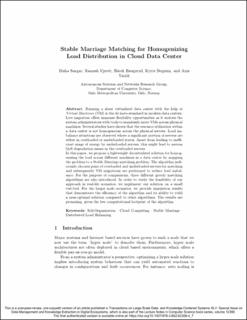| dc.contributor.author | Sangar, Disha | |
| dc.contributor.author | Upreti, Ramesh | |
| dc.contributor.author | Haugerud, Hårek | |
| dc.contributor.author | Begnum, Kyrre | |
| dc.contributor.author | Yazidi, Anis | |
| dc.date.accessioned | 2021-02-01T17:50:47Z | |
| dc.date.accessioned | 2021-03-10T11:50:12Z | |
| dc.date.available | 2021-02-01T17:50:47Z | |
| dc.date.available | 2021-03-10T11:50:12Z | |
| dc.date.issued | 2020-09-20 | |
| dc.identifier.citation | Sangar D, Upreti R, Haugerud H, Begnum KM, Yazidi A. Stable marriage matching for homogenizing load distribution in cloud data center. Transactions on Large-Scale Data- and Knowledge-Centered Systems. 2020;45:172-198 | en |
| dc.identifier.isbn | 978-3-662-62307-7 | |
| dc.identifier.isbn | 978-3-662-62308-4 | |
| dc.identifier.issn | 1869-1994 | |
| dc.identifier.uri | https://hdl.handle.net/10642/9967 | |
| dc.description.abstract | Running a sheer virtualized data center with the help of Virtual Machines (VM) is the de facto-standard in modern data centers. Live migration offers immense flexibility opportunities as it endows the system administrators with tools to seamlessly move VMs across physical machines. Several studies have shown that the resource utilization within a data center is not homogeneous across the physical servers. Load imbalance situations are observed where a significant portion of servers are either in overloaded or underloaded states. Apart from leading to inefficient usage of energy by underloaded servers, this might lead to serious QoS degradation issues in the overloaded servers.
In this paper, we propose a lightweight decentralized solution for homogenizing the load across different machines in a data center by mapping the problem to a Stable Marriage matching problem. The algorithm judiciously chooses pairs of overloaded and underloaded servers for matching and subsequently VM migrations are performed to reduce load imbalance. For the purpose of comparisons, three different greedy matching algorithms are also introduced. In order to verify the feasibility of our approach in real-life scenarios, we implement our solution on a small test-bed. For the larger scale scenarios, we provide simulation results that demonstrate the efficiency of the algorithm and its ability to yield a near-optimal solution compared to other algorithms. The results are promising, given the low computational footprint of the algorithm. | en |
| dc.language.iso | en | en |
| dc.publisher | Springer | en |
| dc.relation.ispartofseries | Transactions on Large-Scale Data- and Knowledge-Centered Systems; Volume 12390 | |
| dc.rights | Authors whose work is accepted for publication in a non-open access Springer book may deposit their author’s accepted manuscript (AAM) in their institutional or funder repository. | en |
| dc.subject | Self-organization | en |
| dc.subject | Cloud computing | en |
| dc.subject | Stable marriages | en |
| dc.subject | Distributed load balancing | en |
| dc.title | Stable marriage matching for homogenizing load distribution in cloud data center | en |
| dc.type | Journal article | en |
| dc.type | Peer reviewed | en |
| dc.date.updated | 2021-02-01T17:50:47Z | |
| dc.description.version | acceptedVersion | en |
| dc.identifier.doi | https://doi.org/10.1007/978-3-662-62308-4_7 | |
| dc.identifier.cristin | 1884633 | |
| dc.source.journal | Transactions on Large-Scale Data- and Knowledge-Centered Systems | |
